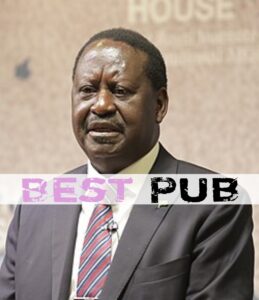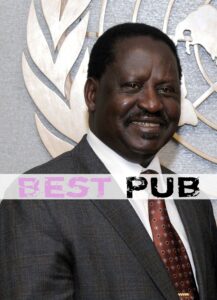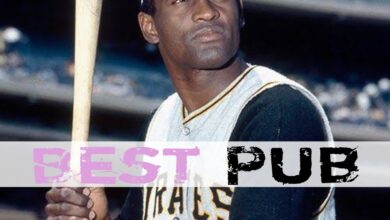Raila Odinga Biography: The Complete Account, Verified Records & Legacy

Raila Amolo Odinga was a towering figure in Kenyan politics, renowned for his long struggle for democracy and social justice. He was born on January 7, 1945, in Maseno, Kenya, making his age a full 80 years at the time of his death on October 15, 2025. He was the son of Jaramogi Oginga Odinga, Kenya’s first Vice President. This family legacy instantly placed him at the heart of the country’s political arena.
Also Read: Mbugua Kimani Biography: The Complete Account, Verified Records & Legacy
His education involved early schooling in Kenya before he travelled to East Germany. He first attended the Herder Institution, where he learned German. He later earned a scholarship to study at the Technical School, Magdeburg (now part of the Otto von Guericke University Magdeburg). He returned home in 1970 with a Master of Science degree in Mechanical Engineering.
Odinga started his career and profession outside politics. He first worked as a lecturer at the University of Nairobi. However, he soon ventured into business. He established Standard Processing Equipment Construction and Erection Limited, a company later renamed East African Spectre. This company specializes in manufacturing LPG cylinders, showcasing his engineering background. He also worked in the public service as a Deputy Director at the Kenya Bureau of Standards (KeBS) from 1978 to 1982.
Odinga’s political work defined his life. He became a fierce opposition figure, fighting the one-party rule of President Daniel arap Moi. Consequently, he faced immense hardship. He was arrested and detained without trial for six years after being accused of plotting the 1982 coup attempt. His repeated detentions cemented his status as a pro-democracy activist and political prisoner.
After the return of multiparty politics, Odinga was elected Member of Parliament for Lang’ata Constituency in 1992. He served as a Cabinet Minister under both President Daniel arap Moi and President Mwai Kibaki, holding portfolios like Minister for Energy and Minister for Roads, Public Works and Housing.
His greatest political success and achievement came in 2008. Following the highly contentious 2007 election, a power-sharing agreement led to his appointment as the Prime Minister of Kenya (the second and last person to hold the office) from 2008 to 2013. Furthermore, he is widely credited as a champion of the 2010 Constitution, which introduced key democratic reforms. Although he ran for president five times, he remained a powerful political kingpin and a key leader of the opposition movement, most recently through the Azimio la Umoja coalition. From 2018 to 2023, he held the continental work of African Union High Representative for Infrastructure Development. His passing was a significant moment in Kenyan history.
Raila Odinga Early Life and Family Background
Raila Amolo Odinga was born on January 7, 1945, in Maseno, Kisumu County, in Kenya’s former Nyanza Province. Raila Odinga is a prominent member of the Luo community, one of Kenya’s largest ethnic groups. Raila Odinga‘s birthplace and heritage deeply influenced his political trajectory. Raila Odinga‘s father, Jaramogi Oginga Odinga, was a titanic figure in Kenya’s struggle for independence and served as the country’s first Vice President. This strong, early exposure to liberation politics was a fundamental influence on the younger Raila Odinga. Raila Odinga‘s mother was Mary Juma Odinga. Growing up, the Luo leader’s family was at the epicenter of Kenya’s political upheavals. His father’s principled stand against President Jomo Kenyatta led to political detention and marginalization. This family legacy of defiance and reformist zeal instilled in young Raila Odinga a lifelong commitment to fighting for democratic change. The atmosphere in the Odinga household was one of constant political discussion and resistance. This environment directly shaped his worldview and his future role as a perennial Kenyan opposition figure and a lifelong democracy advocate. Raila Odinga learned the cost of standing up to power from a very young age.
Raila Odinga Education and Academic Achievements
Raila Odinga’s formative years in education laid the groundwork for his career as an engineer and later as a complex political figure. Raila Odinga attended prestigious institutions like Maseno School for his early education. A significant turning point came in 1962 when Raila Odinga received a scholarship to study in East Germany, a decision that would heavily influence his political and professional life. Raila Odinga first attended the Herder Institution, a language school, which was part of the University of Leipzig, before moving to his main university. Raila Odinga proceeded to study at the Technical University of Magdeburg (now part of the Otto von Guericke University Magdeburg) in the German Democratic Republic (GDR). From this institution, Raila Odinga earned a Master of Science degree in Mechanical Engineering in 1970. This achievement made Raila Odinga one of the pioneering Kenyan engineers abroad. Raila Odinga‘s technical background is often seen as a contrast to his later populist political style, highlighting the intellectual breadth of the man. After returning to Kenya, Raila Odinga briefly lectured at the University of Nairobi’s Department of Mechanical Engineering before transitioning into entrepreneurship and civil service at the Kenya Bureau of Standards (KeBS). His engineering training instilled a methodical and problem-solving approach. This foundation in technical analysis has occasionally surfaced in Raila Odinga‘s political life, particularly in arguments concerning public policy and election integrity.
Raila Odinga Political Career Timeline
Raila Odinga‘s political career is an epic saga defined by struggle, detention, and high office. His active political engagement began in the 1980s, culminating in his arrest and prolonged detention without trial following the 1982 coup attempt against President Daniel arap Moi’s one-party state. Raila Odinga was held for six years and later detained two more times for his pro-democracy agitation. His time in prison solidified his reputation as a Kenyan reformist. Upon his release and return from exile in 1992, Raila Odinga joined the push for multi-party democracy movement. Raila Odinga was first elected as the Member of Parliament for Langata Constituency. A series of political realignments followed, demonstrating Raila Odinga‘s tactical brilliance. Raila Odinga was a co-founder of the National Rainbow Coalition (NARC), which swept President Moi’s KANU party out of power in the 2002 election. Raila Odinga served as a Cabinet Minister in various roles, including Minister for Energy. A key moment came in 2005 when Raila Odinga led the opposition to a government-proposed constitutional draft, which was rejected by voters, symbolically marked by the “Orange” of the rejection campaign. This led Raila Odinga to form the Orange Democratic Movement (ODM) party, which remains a major force. Following the disputed 2007 election and the ensuing violence, a power-sharing agreement was brokered. This historic deal saw Raila Odinga served as Prime Minister (2008–2013) under President Mwai Kibaki. Raila Odinga played a crucial role in stabilizing the nation during this challenging period.
Raila Odinga Major Political Campaigns and Elections
Raila Odinga‘s presidential ambition has been a defining feature of Kenya’s political landscape for over two decades. Raila Odinga has mounted an unprecedented five presidential bids: 1997, 2007, 2013, 2017, and 2022. Each campaign has been fiercely contested and often marred by controversies and electoral disputes. The 2007 election was particularly turbulent. Raila Odinga‘s narrow loss to Mwai Kibaki led to a devastating post-election crisis fueled by ethnic violence. The subsequent international mediation resulted in the reconciliation efforts that established the grand coalition government, where Raila Odinga became Prime Minister. In the 2013, 2017, and 2022 general Kenyan elections, Raila Odinga ran under different coalition banners, including the National Super Alliance (NASA) and the Azimio la Umoja coalition. His persistent challenges to results have profoundly impacted the role of the IEBC (Independent Electoral and Boundaries Commission). Notably, in 2017, his petition to the Supreme Court led to the nullification of the presidential election, a first in Africa. Perhaps Raila Odinga‘s most surprising political move was the “handshake with Uhuru Kenyatta” in March 2018. This was a public reconciliation with his former rival, then-President Uhuru Kenyatta, which dramatically shifted the political dynamics, creating a temporary working relationship focused on national healing and unity, putting aside years of rivalry for the sake of peace.
Raila Odinga Legacy and Impact on Kenyan Democracy
Raila Odinga‘s enduring legacy is fundamentally tied to his role as a relentless champion of constitutional reform and civil liberties. Raila Odinga has earned the title of Kenyan reformist through decades of agitation against authoritarianism. Raila Odinga‘s greatest single contribution to the nation’s legal and political framework is arguably his immense influence as an architect of the 2010 Constitution. This document ushered in a decentralized system of government and enshrined numerous human rights provisions. It remains a watershed moment in Kenya’s democratic evolution, a direct result of the pro-reform pressure Raila Odinga helped sustain. His commitment extended into the post-handshake era with the BBI (Building Bridges Initiative). This initiative, jointly spearheaded with President Kenyatta, sought further constitutional changes to address issues like ethnic antagonism and corruption. Although the BBI initiative was ultimately nullified by the courts, it cemented Raila Odinga‘s image as a figure continually pushing for the restructuring of the Kenyan state. Raila Odinga‘s political style is characterized by mass mobilization. This has given Raila Odinga significant influence on youth and grassroots mobilization. The nickname “Baba” (Father) reflects Raila Odinga‘s status as a national patriarch of the opposition, a figure who commands deep, almost filial, loyalty among his supporters. Raila Odinga consistently challenges the status quo, ensuring that issues of governance and accountability remain at the forefront of the national conversation, thus safeguarding the hard-won democratic space.
Also Read: James Orengo Biography: The Complete Account, Verified Records & Legacy
Raila Odinga Personal Life and Family
Behind the towering public figure of “Baba” is a committed family man. Raila Odinga is married to Ida Odinga (born Ida Anyango Oyoo). Their marriage, which began in 1973, is a partnership that has endured decades of political turmoil, including the long periods of his detention. Ida Odinga is a powerful figure in her own right—an educator, activist, and businesswoman who provided the foundation of stability during her husband’s years of struggle. They raised four children together: the late Fidel Odinga, Rosemary Odinga, Raila Odinga Jr., and Winnie Odinga. The family faced enormous stress when Raila Odinga was a political prisoner in the 1980s. Ida had to raise the children while facing constant harassment and surveillance from the government. The tragic loss of their eldest son, Fidel Odinga, in 2015, was a profound personal blow to the entire Odinga family and the nation. The family’s story is a powerful illustration of the private cost of public service in the high-stakes world of Kenyan political dynasties. Despite the public spotlight, the family remains a visible and influential unit. Their personal sacrifices have shaped Raila Odinga’s image, contrasting the fierce politician with a man whose life has been deeply affected by love and loss. The resilience of the family is often cited by supporters as evidence of his human, relatable side.
Raila Odinga Net Worth and Business Interests
The financial profile of Raila Odinga is a subject of frequent public interest and debate, often linked to the term “political wealth.” While his actual Raila Odinga net worth is difficult to state with certainty due to the private nature of his assets, Raila Odinga is widely considered one of the more affluent figures in Kenyan politics. His wealth is primarily rooted in successful business ventures that predate and run parallel to his political career. Raila Odinga is an industrialist with significant interests in the energy and manufacturing sectors. Raila Odinga is the founder of Standard Processing Equipment Construction & Erection Ltd, a company that was later renamed East African Spectre (a gas cylinder manufacturing company). This company is a key part of Raila Odinga‘s business portfolio. Additionally, Raila Odinga is reported to have had interests in the petroleum sector through companies like Pan African Petroleum. His investments are diverse, spanning manufacturing, energy, and real estate interests, placing Raila Odinga among Kenya’s influential business elite. Public and media estimates of Raila Odinga‘s wealth vary wildly, sometimes placing Raila Odinga as a major Kenyan billionaire. However, a large portion of the Odinga family’s wealth has historical roots in the commercial activities initiated by his father, Jaramogi Oginga Odinga. His financial independence, however, is a key component of Raila Odinga‘s political strength, enabling him to fund his formidable electoral machine over multiple cycles.
Raila Odinga Net Worth and Financial Interests
Raila Odinga Net Worth is estimated to be in the multi-billion Kenyan shilling range, accumulated through decades of public service, business ventures, and strategic investments.
Raila Odinga built a substantial business empire alongside his political career. His wealth stems from real estate holdings in Nairobi and Mombasa, energy and manufacturing interests, and family-run investment structures. He maintained a low profile regarding his financial dealings, but reports highlight his ownership of luxurious estates and stakes in various companies across East Africa.
Raila Odinga Wife: Ida Odinga
Raila Odinga wife is Ida Odinga. She is a respected educator, businesswoman, and advocate for women’s rights in Kenya.
Raila Odinga Age and Date of Birth
Raila Odinga age is 80 years old as of 2025. He was born on January 7, 1945.
Raila Odinga Cause of Death
The cause of death for Kenyan political icon Raila Amolo Odinga was cardiac arrest.
Raila Odinga died on October 15, 2025, at the age of 80. The former Prime Minister was traveling in India at the time of his passing, where he was undergoing medical treatment at an Ayurvedic facility in Koothattukulam, Kerala. Reports indicate that he collapsed during a morning walk within the premises of the facility. He was rushed to a nearby hospital but was pronounced dead after resuscitation efforts were unsuccessful. His death, which occurred outside of Kenya, was a significant event that shook the East African nation and prompted a declaration of seven national days of mourning by the sitting President. The official confirmation of cardiac arrest brought to a close the life of a leader whose enduring political career spanned over four decades and profoundly shaped Kenya’s journey to multiparty democracy.
Also Read: Anthony Kibagendi Biography: The Complete Account, Verified Records & Legacy
Raila Odinga Children and Family Life
Raila Odinga children include the late Fidel Odinga, Rosemary Odinga, Raila Odinga Jr., and Winnie Odinga. Each has played various roles in public life, with Winnie Odinga notably serving as a Member of the East African Legislative Assembly.
Raila Odinga Profile Table: Quick Facts

| Profile | Information |
| Raila Odinga career | Politician (Former Prime Minister, Leader of Opposition, MP), Engineer, Businessman, Lecturer |
| Raila Odinga real name | Raila Amolo Odinga |
| Raila Odinga age | 80 (At time of death on October 15, 2025) |
| Raila Odinga date of birth | January 7, 1945 |
| Raila Odinga net worth | Disputed/Varies (Reported business interests in energy, manufacturing, and real estate) |
| Raila Odinga wife / spouse | Ida Odinga (m. 1973) |
| Raila Odinga children | 4 (Fidel Odinga, Rosemary Odinga, Raila Odinga Jr., Winnie Odinga) |
| Raila Odinga parents | Jaramogi Oginga Odinga (Father), Mary Juma Odinga (Mother) |
| Raila Odinga religion | Born-again Christian (Protestant/Anglican) |
| Raila Odinga state of origin | Kisumu County (Born in Maseno, Nyanza Province) |
| Raila Odinga alma mater | Otto von Guericke University Magdeburg (formerly Technical University of Magdeburg) |
| Raila Odinga education | M.Sc. in Mechanical Engineering |
| Raila Odinga nationality | Kenyan |



